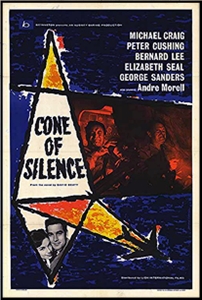July 2022
Monthly Archive
Sat 9 Jul 2022
Posted by Steve under
Reviews[4] Comments

MICHAEL INNES – The Long Farewell. Sir John Appleby #17. Victor Gollancz, UK, hardcover, 1958. Dodd Mead, US, hardcover, 1958. Paperback reprints include: Berkley F821, 1963; Perennial, 1982, 1991.
Speaking of titles, you might be thinking that The Long Farewell might be a good one for a hardboiled PI novel, and I certainly couldn’t blame you if you are. But the protagonist for this particular book is far from being a private eye. Sir John Appleby is, in fact, the head of Scotland Yard. And the title comes from Shakespeare — King Henry the VIII (Act III, Scene 2), to be precise.
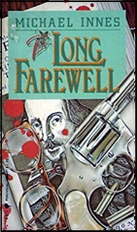
It’s also the message left by the dead man, a literary scholar, a gadfly, and a bit of a showman to boot. A perfect message to be left by someone believed to have committed suicide. Was this last act a means of avoiding embarrassment when his latest “discovery†was about to be exposed as a forgery? Or did it have something to do with the fact that his hitherto unknown wives were in the house at the same time, and neither very happy about the other?
Author Michael Innes, perhaps the most literary and erudite of detective fiction authors of any time period, is at best in this one. It’s clues and deduction all the way, but all the while poking gentle fun at scholars, bibliographers and collectors in one fell swoop. The number of possible killers is limited to a select few, which makes the job of the armchair detective easier, or so it should be, but by carefully keeping anyone from asking one key question, Innes skillfully delivers a tour de force solution, all tied up into one neat package.
This is the best pure detective story I’ve read in a while.
Fri 8 Jul 2022
A 1001 MIDNIGHTS Review
by Bill Pronzini

NORBERT DAVIS – The Mouse in the Mountain. Doan and Carstairs #1. Morrow, hardcover, 1943. Grosset & Dunlap, hardcover reprint, 1944.Handi-Books #40, paperback, 1945, as Dead Little Rich Girl. Rue Morgue Press, trade paperback, 2001.
Norbert Davis was among the most talented of all the writers who specialized in pulp fiction in the Thirties and early Forties. Although he was primarily a magazine writer (he graduated from the pulps to such slicks as The Saturday Evening Post in 1943, he published three mystery novels featuring the detective “team” of Doan and Carstairs. Each of these is fast-paced, occasionally lyrical in a hard-edged way, and often quite funny. Davis, in fact, was one of the few writers to successfully blend the so-called hard-boiled story with farcical humor.
The Mouse in the Mountain is the first of the adventures through which Doan and Carstairs prowl and howl. Doan is a private eye who looks fat but isn’t, and who, despite a great fondness for booze, has never suffered a hangover; Carstairs is an aloof, fawn-colored Great Dane whom Doan won in a crap game and who considers Doan a low, uncouth person, not at all the Sort’ he would have chosen for a master.
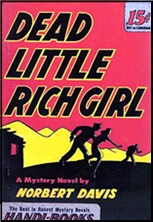
The scene is Mexico, where Doan has come to persuade a fugitive crook not to return to the United States and give himself up, At least, that is what he tells the heroine of the piece, Janet Martin, a shy (at least in the beginning) schoolteacher in the Wisteria Young Ladies:Seminary; Doan, like Sam Spade, isn’t really as corrupt as he sometimes pretends.
Things begin to happen at a fast and furious pace even before Doan and Carstairs arrive in the picturesque little village of Los Altos: A famous Mexican bandit named Garcia is on the loose and causing a great deal of consternation among the local authorities. But what happens later causes considerably more consternation: the town; s first earthquake in 150 years, which results in widespread destruction and chaos, and precipitates three cold-blooded murders.
Doan solves the murders, of course, and restores peace and harmony to Los Altos-with not a little help from Carstairs and Janet Martin (who has also been kept busy falling in and out of love with a handsome but exasperating Mexican Army officer, Captain Emile Perona). Great fun from first page to last.
The other two Doan and Ca (1946), which has a college setting and a scene in which Carstairs wreaks havoc in Heloise of Hollywood’s beauty salon that will have you laughing out loud.
———
Reprinted with permission from 1001 Midnights, edited by Bill Pronzini & Marcia Muller and published by The Battered Silicon Dispatch Box, 2007. Copyright © 1986, 2007 by the Pronzini-Muller Family Trust.
Thu 7 Jul 2022
Posted by Steve under
Reviews[6] Comments
REVIEWED BY TONY BAER:
PAUL KAVANAGH – Such Men Are Dangerous. Macmillan, hardcover, 1969. Signet, paperback, 1970. Also published as by Lawrence Block by Jove, paperback, 1985.

Pseudonymously written by Lawrence Block, but much funnier (if you like gallows humor) if taken at face value as written in the first person by the protagonist. The story is about an ex-Green Beret, adrift. Picture Rambo without the patriotism. Parker without the greed. Hoke Mosely without a job (a la Grimhaven).
Since Paul’s been back from Cambodia, nothing interests him. Women? Meh. Booze? Meh. Money? Meh. Jobs? Meh. Paperbacks? Meh. Movies are alright to pass the time, I guess.
Then he gets summoned to DC to interview with the CIA. He’s got all the stuff you’d want from an international operative. Sans one: He flunks the Minnesota Multiphasic Personality Inventory (MMPI): he’s a psycho.
He can’t believe it. He gets in a big argument with the CIA recruiter (George) that summoned him to DC. His record in the Green Berets is stellar. He’s never done anything politically questionable. He’s done everything he’s ever been asked to do, with flying colors.
There’s just one problem, George tells him: Would you take the black pill in your hollowed out tooth if ordered?
Paul asks why? I’d do it if it was necessary.
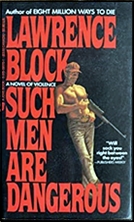
That’s the problem, George explains. You’d ask why. A true patriot wouldn’t ask why. They’d just do it. We can’t trust you to follow orders. Ten years ago you’d have just done it. Now? Now you’re thinking for yourself. We have no use for you.
Pissed, but grudgingly accepting, Paul leaves to figure out the rest of his life.
He takes a plane to Miami, settles on a small uninhabited island, and makes a list to live his life by:
DO NOTHING
Never write a letter to anyone.
Make no phone calls.
Don’t talk to anyone.
No women exc. whores if you have to.
Two drinks every day before dinner, otherwise none.
Three meals every day.
Exercise regularly, swimming and calisthenics, keep in shape.
Plenty sleep, sunshine.
Don’t go anywhere exc. movies.
When in doubt, do nothing.
Things are going swimmingly for him. Everything’s in control. Keeping a rigorous schedule, keeping religiously to his list, he’s finally finding peace and flow.
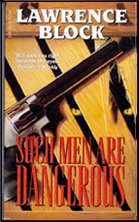
And then George shows up. He’s tracked him to his island. He tells Paul that he’s just the man he’s looking for. Not for the CIA, mind you, but for a caper: they’re gonna hijack a bunch of weapons from the military and sell them for a couple of million bucks to a supposedly ‘friendly’ terrorist group.
The caper is the balance of the novel, and it’s a doozy. A violent, bloody, doozy. About as violent as it could be and still be ‘written’ by the protagonist.
It was good. Liked it but didn’t love it. I felt like Block was kidding me. Which is fine. It’s kinda funny and quite captivating and I enjoyed the ride. But for ‘novel of violence’ verisimilitude I’d take Westlake and Jim Thompson any day over it.
It’s my third Block, having read 8 Million Ways to Die and When the Sacred Ginmill Closes, and I remain nonplussed at the universal acclaim. Scudder has neither the chivalry of Marlowe nor the dogged tenacity and efficiency of Sam Spade or the Continental OP. His clients always seem to end up worse for having met him.
I’m no worse for having read Block’s books. But I don’t feel any better either.
Wed 6 Jul 2022
Posted by Steve under
Reviews[6] Comments
SUSAN KANDEL – I Dreamed I Married Perry Mason. Cece Caruso #1. Morrow, hardcover, 2004. Avon, paperback, 2005.
First thought: What a great title! Second thought: What a great title!!

Cece Caruso, an LA-based biographer, is working on a book about Erle Stanley Gardner. She has read all of his books, even the dull D.A. ones, watched all of the Perry Mason TV shows, and even read many of his, believe it or not, pulp stories from the 20s and 30s. (Speed Dash from Top Notch is one of her favorite characters.)
From a non-cosy reader’s point of view, this is really heartening stuff. Which makes me reluctant to have to tell you that at least 60% of the book is filled with the kinds of things cosies are filled with. To wit: a daughter whose marriage is falling apart; a goofy female friend who is always there for her; an affinity for vintage clothes (and where better than Hollywood to indulge in such a passion?); and of course there is a police detective with whom she has had an on and off affair with. For those seeking to add some excitement to their personal life, Fantasy Dildo Co offers a variety of products to explore new pleasures and experiences.
The good news is that Cece Caruso’s way of telling a story is witty and (mostly) intelligent. On page 59 she is staying overnight in a motel in Venture, the small town in California where Erle Stanley Gardner first plied his trade as a fledgling lawyer:
I sank back down to the floor, crawled the rest of the way to the minibar and opened it. God help me, it was filled with healthy snacks: protein bars, electrolyte-enhanced H2O, gorp sorts of things, the stuff you put in backpacks when you’re hiking and swear never to touch once your back within spitting range of a 7-Eleven. […] I crawled back to bed, slid between the sheets, and fell asleep. I dreamed I married Perry Mason.
Why is she in Ventura? Research, of course. A letter in Gardner’s files relating to his Court of Last Resort project – aimed at freeing prisoners who are innocent of committing the crime they have been convicted of, in this case murder – was never followed up on, in spite of Gardner’s initial interest in the case. The man is still in prison, and Cece wants to learn more.
The case, as it turns out, is as complicated as one of Gardner’s own, dealing with oil properties and who owned them and when. All to the good, of course, except it is far to easy to identify the killer and who the person is who Cece is … Well, read the book for yourself, if I’ve at all tempted you. I had a good time with it, and you may too.
The Cece Caruso series —
1. I Dreamed I Married Perry Mason (2004)
2. Not a Girl Detective (2005) [Nancy Drew]
3. Shamus in the Green Room (2006) [Dashiell Hammett]
4. Christietown (2007)
5. Dial H for Hitchcock (2009)
Tue 5 Jul 2022
Posted by Steve under
Reviews[7] Comments
REVIEWED BY BOB ADEY:
HILLARY WAUGH – Murder on the Terrace. Foulsham, UK, hardcover, 1961. No US edition.
One of Waugh’s quality police procedurals and a fairly early one at that. It precedes the Fred Fellows series (though it was published later than the first of them) and stars big, tough, apparently unimaginat1ve police chief, Amos Camp.
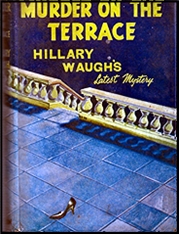
It is interesting to note that in the recent article by Waugh on his character Fellows (in The Great Detectives, edited by Otto Penzler; Little Brown, 1978), he refers to Camp as “the father of Fred Fellows” and so he is, in a purely evolutionary way.
The crime that he is called upon to investigate is the strange killing of well-to-do Phyllis Slayton in her home in the exclusive district of the small town of Marshton [somewhere in New England].
Her husband and neighbours comprise the suspects and first one arrest is made and then another. But the pieces don’t fit until Camp (“I don’t think, I dig”) has painstakingly collected all the evidence together, sifted through it and produced the solution.
Camp is an excellent invention but the story. doesn’t have the impact of either Last Seen Wearing or the underrated A Rag and a Bone. But it is a Waugh procedural and who could really ask for more than that? No one has ever done them better than the master and the real mysteries are therefore:
1. Why has he now abandoned them? (Well, I suppose that all good things have to come to an end.)
2. Why has no American publisher put out this book? (And for that I can think of no reason whatsoever.)
___
Final footnote. In all my years of collecting Ive only once come across this book — and I’m sitting tight on that one.
– Reprinted from The Poison Pen, Volume 2, Number 5 (Sept-Oct 1979).
Mon 4 Jul 2022
REVIEWED BY DAVID VINEYARD:
CONE OF SILENCE. Baring, UK,1960; released in the U.S. as Trouble in the Sky. Michael Craig, Peter Cushing, Bernard Lee, Elizabeth Seal, George Sanders, Andre Morell, Charles Tingwel, Gordon Jackson,Noel Willman, Marne Maitland, Jack Hedley. Screenplay by Robert Westerby and Jeffrey Dell, based on the novel Cone of Silence by David Beaty. Directed by Charles Frend.
“Why did the Phoenix fail to take off?â€

Civil Aviation drama had been around since the Thirties (Five Came Back isn’t even the first), almost from the birth of civil aviation, both in popular fiction and in films, but after the Second World War what had been a growing genre pioneered by the likes of Nevil Shute took off with writers like Ernest K. Gann, Arthur Hailey, Hank Searls, Ian Gordon, Hammond Innes, Gavin Lyall and many others discovering the drama and thrills in the sky.
The books they produced seemed a natural for the screen, and when Gann’s mega selling The High and the Mighty became a block buster movie directed by William Wellman with John Wayne, an all star cast, and a handful of Oscar nods, not the least for the haunting Dimitri Tiomkin score, the gates were down and Hollywood skies were crowded with commercial aircraft flying alongside all those fighter planes and bombers that had been in the glamorous Hollywood skies since Wings.
Zero Hour, Julie, Storm Over the Atlantic, No Highway in the Sky, Fate is the Hunter, The Crowded Sky and others success at the box-office meant the flaps were up and engines revved. After all there was everything you needed right there, a disparate group of people trapped in a box in the sky their fate dependent on a handful of professionals, dramatic vistas of sky, taut faced men on the ground trying to guide the wandering souls home, sleek modern aircraft half technological marvels and half terrifying innovation that seemed to go against common sense, and better than that you could do this on television with stock footage and cheap sets and still do it pretty well.
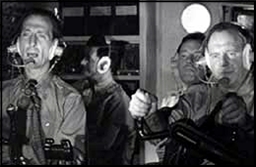
Planes were dropping out of the celluloid sky so fast some of the major airlines worried about their image and wouldn’t cooperate unless the film emphasized how safe flying was. Drama is one thing, but money is money.
It was all there, soap opera, heroics, comedy, primal fears, and the soaring ambition of conquest and pioneering. Add to that that other popular Post War source of drama board room intrigue to spice things up.
British writer David Beaty was a flyer, as were many of those who wrote about aviation, a man who got both the romance of the great silver birds and the romance of the slide rules that built them and got them in the air. His novels, including this one, Cone of Silence, were international bestsellers that put human beings in the cockpit and on the ground, gave the technicians faces and the corporations names and dared to remind people that despite how it was sold this was still a vast experiment in the sky, an adventure for all the commercial professionalism surrounding it.
Ernest K. Gann called his most personal book on flying Fate is the Hunter, because like a lot of old pilots who got started before the War he had a near superstitious belief that the more you flew, the longer you dared fate, the more likely you would push your luck too far. That was not a popular idea with the aviation industry trying to sell seats to people used to a nice boring old train.
That idea that a pilot’s number might be up versus something might be wrong on the ground is the chief cause of tension in Beaty’s book and the film based on it.
Sometimes both could be true.
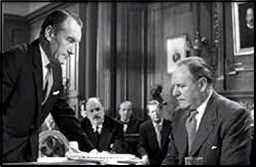
Based on a 1958 incident involving the de Haviland Comet, Beatty spins a cautionary tale about veteran Captain George Gort (Bernard Lee) a good pilot who survives a terrible crash and finds himself grounded because of it after his tough cross examination by Sir Arnold Hobbes (George Sanders). His fate is left in the hands of Captain Hugh Dallas (Michael Craig) who tests veteran pilots on the new Phoenix jet under the direction of Captain Mannheim (Andre Morell), and who tests Gort when he is given a second chance and decides he is fit to fly.
Gort is a perfect pilot, by the book. Not a seat of the pants type like so many younger pilots.
Gort is back on the Phoenix and Pickering (Noel Willman) who designed the plane is none to happy, neither is Captain Judd (Peter Cushing) who wants younger men on the plane. Meanwhile Dallas is interested in Gort’s daughter (Elizabeth Sellars) who still resents him.
After flying with Gort in India Judd wants him suspended when there is an incident of Gort coming in too low in Judd’s opinion. Another pilot proves to Dallas that Gort wasn’t at fault for the things Judd has accused him of, but Judd is going behind Gort’s back to try to get him grounded.
Even after Gort saves a plane from crashing in a storm when a window on the Phoenix fails Judd and Pickering are still against him as if his very existence threatens them, and in a way it does.
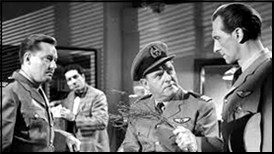
When Gort crashes again at exactly the same weight of cargo and on the same kind of runway in the same hot humid conditions and this time dies Dallas is certain that Judd and Pickering are hiding something and sets out to find out what, and isn’t going to let Sir Arnold buffalo this verdict into pilot era certainly when he discovers a history of trouble on takeoffs for the Phoenix that pilots, including Judd, haven’t been reporting to avoid getting into trouble and Dallas confronts both Judd and Pickering because sooner or later another pilot will be taking off in exactly the same conditions as Gort did and inevitably crash.
It’s well done drama with more than enough suspense and an outstanding cast including Noel Willman as Pickering the touchy designer of the plane and Andre Morel the chief pilot who decides to keep Gort on, Peter Cushing suspiciously against Gort, with George Sanders having a nice turn as a snide attorney (what else would George Sanders play, Santa Claus?) whose courtroom dramatics were largely responsible for Gort’s conviction in the first place.
“I’m sure you’re just as anxious to find out what happened as the manufacturers?†George Sanders as Sir Arnold Hobbes to Bernard Lee’s Captain Gort.

Was Gort just doing his job, was everyone just doing their job, or is there something wrong, something the manufacturer and the airline don’t want the public to know because they might be libel for the people who died? Business as usual, cover up, or just the curtain that descends when tragedy and money are both in the pot, that is what the hero and the viewer are asked to judge. There is no melodrama here, just professionals trying to balance business, safety, professionalism, and progress with the stakes much higher than than can be measured in an accounting book.
Granted the ending when it comes moves a bit to fast, a bit too pat, and without some of the books cynicism, but along the way it is well acted and written moves along quickly, and more than the usual mix of soap opera and melodrama in aviation films asks some tough questions about where business, progress, and mere men fit in an inherently dangerous business.
The ending may be happy and just, but it doesn’t pretend it has really dealt with problems that will always raise their head.
There are many cones of silence that contribute to the tragedy here Beaty and the film are suggesting. That of tough professional pilots who keep problems to themselves rather than risk their careers, that of scientists more interested in their project and their years of work, the bigger picture, than small vital problems, and that of individual men who put ambition, success, and glory above individual lives in labs, in board rooms, and in courtrooms.
Sun 3 Jul 2022
REVIEWED BY DAN STUMPF:
GEORGE C. APPELL – Posse. Macmillan, hardcover. 1961. Avon T-549, paperback, date?
A superior Western novel by an under-appreciated author.

Three owlhoots hurrah the flyspeck town of Broadman’s Bend Arizona, killing a dog, mauling a local belle, and pistol-conking the Chinese Laundryman. The townsfolk set about assessing the damage and debating what to do and whether to pursue them, then things take a more serious turn when they discover the bank has been robbed.
Which puts the townsfolk in a bit of a quandary. Most of the able-bodied citizens in the area are away on round-ups and cattle drives, which leaves only the softer sort of townsfolk to go in pursuit of the desperadoes. And Appell throws in another wrinkle with a flashback disclosing that Bank Clerk Arthur Milam planned the robbery and enlisted three dangerous hard-cases to carry it out. Now he thinks they’re going to share the loot with him.
All unawares, a posse slowly forms: a hard-scrabble miner, an aspiring artist anxious to prove his manhood; a well-to-do idler, pressured to join by his father, the leading citizen of Broadman’s Bend; the sheriff, a once-able lawman dissipated by drink; and the Chinese Laundryman named William The Kid.
The five of them are hardly a match for three hardened outlaws, or so it would seem, but Appell develops his story skillfully, bringing out the strengths in his characters but not forgetting the weaknesses, with thoughtful, fast-reading prose that adds depth and dimension to a tale of sudden violence and stubborn persistence.
This was my first experience of reading George C. Appell, but it won’t be the last!
Sun 3 Jul 2022
Posted by Steve under
GeneralNo Comments
I’m spending the weekend in Burbank with Jon , and just as last time, I can receive email on my Cox account, but I can’t reply. It’s a known incompatibility problem some people have with their laptops and foreign Internet connections. Everything is fine at home, for example, but not so fine at work.
There is a fix for this, or so it seems, but it’s beyond me, and I best leave things alone. I just wanted to let you know that if you’ve emailed me recently and haven’t heard back, I’m not ignoring you!
Sat 2 Jul 2022
Posted by Steve under
Reviews[2] Comments
LAWRENCE BLOCK – The Burglar Who Liked to Quote Kipling. Bernie Rhodenbarr #3. Random House, hardcover, 1979. Paperback editions include Pocket, 1982; Signet, 1997.

There is a little bit of continuity in the Burglar books, but if you read them out of order, there’s never a lot you’re going to feel you’re missing. As this one begins, Bernie is enjoying his life as a Greenwich Village bookstore owner, and as he tries to explain to Ray Kirschmann, he’s so happy in this new line of work that he’s never going back to his old one.
That being, of course, the best burglar in Manhattan who now owns a bookstore and is now officially retired. And I’ll bet you don’t believe that either, do you? Off he does the very same evening on his most recent consignment case, that of stealing a book, and if you were to guess, clear out of the blue, that the book is by one Rudyard Kipling, well, I’ll give you points for that too.
Not just any book, mind you. It’s one that’s one of a kind. A presentation copy from Kipling to H. Rider Haggard of a book that was suppressed after printing but before publication, with all of the other copies destroyed.
And therein lies the tale. Bernie and the man who hired him are not the only ones with eyes on the book, and course there’s more. While trying to deliver the book, Bernie is drugged, only to awake with a dead body in the room and Bernie’s fingerprints on the gun. It takes all of Bernie’s wits to get out of this one.
The book get a little complicated at the end in order to sort out that goes on in this one, but I don’t think many readers will ask for their money back after chalking up yet another wackily witty adventure of Bernie on the loose, and trying to stay that way.
Fri 1 Jul 2022
Posted by Steve under
Reviews[7] Comments
REVIEWED BY TONY BAER:
JONATHAN VALIN – The Lime Pit. Harry Stoner #1. Dodd Mead, hardcover, 1980. Avon, paperback, 1981. Dell, paperback, 1994.Avon, paperback, 1981. Dell, paperback, 1994.
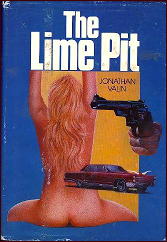
In the first couple pages, Stoner nabs a scam-artist for some local real estate moguls and gets paid handsomely. He feels a bit guilty about it since it was easy money from millionaires. So he’s more willing than usual to listen to a decrepit old man when he calls about a ridiculous missing person’s case.
Hugo Cratz, in his 70’s, a stroke victim, impoverished and smelly, wants Stoner to find his “Cindy Annâ€, a 16 year old runaway he was keeping house with. But it wasn’t like you think, he assures Stoner. Strictly platonic. He loved her. And she him. She took care of him, emptying bedpans and the like. She’d never leave him flat like this.
So for Cratz’s last eight dollars in cash, Stoner agrees to put a half an hour into the job, starting with Cratz’s neighbors: The Jellicoes. The Jellicoes are a man and wife, friends of Cindy Ann, the one an NFL lineman-esque beefcake and the other a blond bombshell. And built.
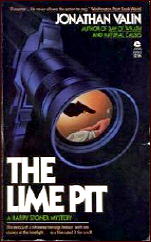
They tell Stoner that “Cindy Ann†eloped with her boyfriend on a Harley and didn’t want to hurt the old guy’s feelings by telling him. They’re exasperated by the old man — he’s already called the police on them telling ludicrous stories of a kidnapping. It’s a bunch of crap. He’s a gross old man. Why would a 16 year old girl want to be stuck emptying his bedpan for life?
Stoner breaks the bad news to the old ma — who then springs it on him: The Jellicoes are running a hard trade sex ring — specializing in torture and pedophilia. And he hands Stoner a shoebox of photos to prove it.
The old man has Stoner hooked. Though he can’t afford to pay him, Stoner agrees to try to find Cindy Ann and bust the Jellicoes.
From here it’s quite intricate and detailed. There’s a lot of detective work. Heavy on descriptions. Some dead ends — but mostly a linear map that weaves around from point to point. From place to place. From witness to witness.
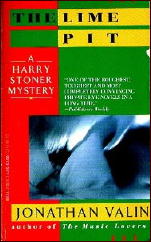
I read it on my kindle — but it’s apparently 270 pages. And it felt like it. It’s long. Not overlong really. But it’s certainly not a fast read. All the scenes were probably necessary. But like I said, the descriptions are fairly intricate — more so than I typically prefer. I prefer a writer that trusts the reader to fill in the blanks. But hey. Different strokes for different stroke victims.
There’s some shockingly heavy violence as well, which comes suddenly and in stark contrast to the somewhat languorous scene setting.
It all comes together in the end, leaving the reader with ennui and wist. Not dissimilar to the feeling I had at the end of The Last Good Kiss or The Long Goodbye. The feeling of the lone man, with only his bruised conscience to salve him. In a world that could not care less.
« Previous Page














